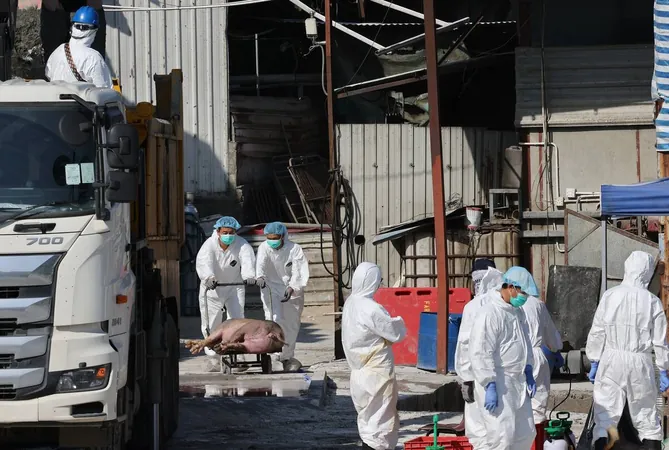
Potential Breakthrough in African Swine Fever Vaccine: What You Need to Know
2025-09-03
Author: Amelia
A Mixed Bag of Results for ASF Vaccine
In a promising yet cautious development, international researchers have unveiled a new vaccine against African swine fever (ASF). However, both researchers and Canadian pork leaders are holding off on celebrations, as the results from recent trials have proven to be mixed.
The Collaborative Effort Behind the Vaccine
Named ASFV-G-ΔI177L, this live vaccine results from a collaborative effort between the United States Department of Agriculture’s Plum Island Animal Disease Center and the International Livestock Research Institute based in Nairobi, Kenya.
Why This Vaccine Matters to the Industry
An ASF outbreak in Canada could devastate the pork industry, impacting animal health and international trade. The stakes are high, especially given that no globally licensed vaccine currently exists to combat this deadly disease.
Insights from the Trials
Recent findings suggest that while the vaccine provides protection against certain ASF strains, its efficacy against others remains limited. Cam Dahl, general manager of Manitoba Pork Council, commented that disappointing outcomes are common in ASF vaccine trials. "Some vaccines, like those tested in Vietnam, have also failed to deliver blanket coverage," he noted.
The Search for Targeted Solutions
Researchers stressed the necessity for vaccines that target regional strains of ASF, indicating a need for tailored approaches in vaccine development. Egan Brockhoff, chief veterinary officer for the Canadian Pork Council, highlighted that this project is groundbreaking, as it’s the first to test a commercial ASF vaccine candidate against lesser-known strains.
Understanding Vaccine Effectiveness
The study categorized the vaccine's efficacy into three levels: strong, partial, and no protection. Strong protection was observed in pigs infected with the same ASF strain used to create the vaccine, while 80% survival was noted in those exposed to a different strain from Ghana. Unfortunately, the vaccine was ineffective against unique strains from Malawi, Kenya, South Africa, and Uganda, despite inducing robust immune responses.
Rethinking Vaccine Strategy
The research team suggests a reevaluation of vaccine classification methods. Traditionally, ASF viruses were categorized based on a single gene, but this approach does not accurately indicate vaccine efficacy. Intriguingly, two viruses with identical sequences yielded different responses in vaccinated swine.
The Global Fight Against ASF
ASF poses a serious threat around the world, having resulted in over two million pig deaths since January 2022. Although Canada and the U.S. have yet to report cases, countries like Vietnam, China, and those in Europe have faced significant outbreaks. The economic implications for the North American pork industry are substantial, with U.S. pork production valued at $27 billion and Canada’s industry contributing over C$6 billion.
How Canada is Staying ASF-Free
Canada has managed to avoid ASF primarily due to a combination of luck and strong biosecurity measures. Notably, the absence of ticks, which can spread the virus, has played a role. The industry has embraced rigorous biosecurity practices on farms and at borders, including the use of sniffer dogs in airports to prevent the import of contaminated products.
Moving Towards Enhanced Biosecurity
The Canadian pork sector, in collaboration with the federal government, is enhancing biosecurity measures, including international zoning arrangements to maintain trade in the event of an outbreak. Brockhoff emphasized proactive policies aimed at mitigating the risks associated with imported feed ingredients and safeguarding the industry’s viability.
Conclusion: A Long Road Ahead
While the recent vaccine findings are a step towards combatting ASF, the journey towards a comprehensive solution is ongoing. The urgency for effective vaccines and robust biosecurity practices cannot be overstated, as the ramifications of ASF are a looming threat that could impact economies and livelihoods across North America.









 Brasil (PT)
Brasil (PT)
 Canada (EN)
Canada (EN)
 Chile (ES)
Chile (ES)
 Česko (CS)
Česko (CS)
 대한민국 (KO)
대한민국 (KO)
 España (ES)
España (ES)
 France (FR)
France (FR)
 Hong Kong (EN)
Hong Kong (EN)
 Italia (IT)
Italia (IT)
 日本 (JA)
日本 (JA)
 Magyarország (HU)
Magyarország (HU)
 Norge (NO)
Norge (NO)
 Polska (PL)
Polska (PL)
 Schweiz (DE)
Schweiz (DE)
 Singapore (EN)
Singapore (EN)
 Sverige (SV)
Sverige (SV)
 Suomi (FI)
Suomi (FI)
 Türkiye (TR)
Türkiye (TR)
 الإمارات العربية المتحدة (AR)
الإمارات العربية المتحدة (AR)